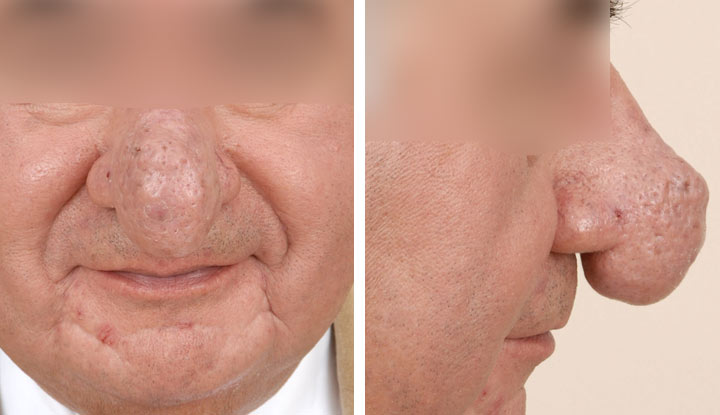Rhinophyma causes your nose to become enlarged, red, bumpy and bulbous at the tip. This skin condition can be an advanced form of rosacea or happen without a rosacea diagnosis. Surgery is the main form of treatment, but there are other options available, too.
Advertisement
Cleveland Clinic is a non-profit academic medical center. Advertising on our site helps support our mission. We do not endorse non-Cleveland Clinic products or services. Policy

Rhinophyma is a skin condition that causes your nose to gradually become large, bumpy and bulb-like at the tip (bulbous). It usually affects the tip of your nose, but may also be on the sides and the skin on top.
Advertisement
Cleveland Clinic is a non-profit academic medical center. Advertising on our site helps support our mission. We do not endorse non-Cleveland Clinic products or services. Policy
It can take several years for rhinophyma to develop. If rhinophyma isn’t treated, the changes may be permanent.
Rhinophyma is also called phymatous rosacea. Rhinophyma is an advanced stage of rosacea. That’s a chronic skin condition that causes skin discoloration, flushing and visible blood vessels.
There are four types of rhinophyma that vary based on the cause of the overgrowth, including:
If you have rhinophyma, the shape, appearance and color of your nose changes gradually.
Signs and symptoms of rhinophyma on your nose include:
Rhinophyma can also affect your mental health. It can affect the way you look and how you feel about your body.
In the early stages, you might have the following on your nose:
Advertisement
An overgrowth of sebaceous glands and/or the underlying connective tissue causes rhinophyma. The reason why this happens isn’t clear.
Rosacea may cause this condition. But you can also have rhinophyma without having rosacea.
People once thought that rhinophyma was the result of drinking a lot of alcohol. But this isn’t true. Rhinophyma occurs in an equal number of people who drink alcohol as in people who don’t drink.
You may be more at risk of developing rhinophyma if you:
A rhinophyma diagnosis usually happens after age 50.
Having a larger nose tip may block your nasal passageway. This may make breathing out of your nose more difficult.
In some cases, a skin cancer known as basal cell carcinoma may develop on your nose. Scientists are still figuring out if rhinophyma plays a role in skin cancer development.
To diagnose rhinophyma, a healthcare provider or skin care specialist (dermatologist) will perform an exam and review your symptoms. They’ll look at your nose and ask you about your personal and family medical history. They’ll ask if you or other known biological family members have a history of rosacea. No other testing is usually needed.
If your symptoms don’t get better after treatment, your provider may order tests, like a skin tissue biopsy, to check for cancer or other conditions.
Your dermatologist may recommend the following treatment options for rhinophyma:
Surgery is another treatment for rhinophyma. The goals of surgery are to:
Surgery is a big decision, so you’ll want to understand the risks and benefits before you decide if it’s right for you. Your provider will make sure surgery is a safe option and that you have realistic expectations about the outcome of the procedure.
You should let your healthcare provider know about any changes in your skin. Take note of areas that are raised, discolored, thickening or swelling.
As rhinophyma is a severe form of rosacea, it’s important to manage rosacea early if you have it. This may prevent rhinophyma. Talk to your healthcare provider about rosacea treatment options.
Advertisement
There isn’t a cure for rhinophyma. Treatment may remove symptoms of the condition. But, while rare, there’s a risk that symptoms may return. Your provider will take all steps necessary to reduce the risk of symptoms coming back in the future.
Your nose is a major feature on your face. But rhinophyma may change your appearance. This change might lead to social isolation or impact your self-esteem. Fortunately, treatment options are available to help you manage symptoms. Treatment can even make breathing easier. Talk to a healthcare provider to see what types of treatment options are available.
Advertisement
Every day, people see your skin, hair and nails. At Cleveland Clinic, our expert and caring dermatology team will make sure they’re healthy and strong.

Last reviewed on 06/18/2025.
Learn more about the Health Library and our editorial process.